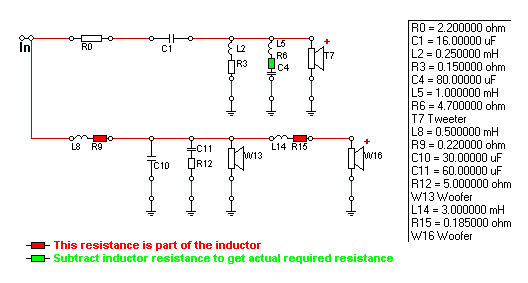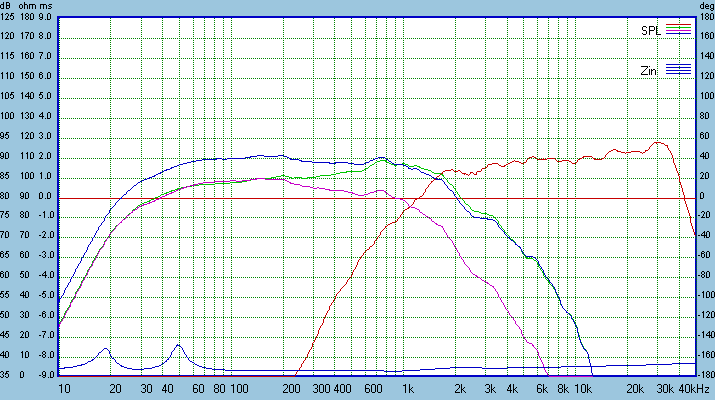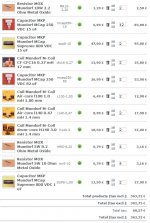Greetings!
I’m not that good in the technical parts of building speakers (yet ;D), but not that bad in wood working.
I have been drooling over the Zaph revelator towers 2.5 (Zaph|Audio - ZRT - Revelator Tower) for a long time now, and I’m looking for someone that wants to clarify some things to get me closer to my dream. ^^,
First ambiguity:
Should I make these 2.5 way speakers with separate equal sized chambers for each woofer?
Aren’t the ZRT a bad construction by not being in that way?…
My point is that, when the .5 woofer are not “playing”, the other woofer is “playing” in a twice as big chamber that it is designed for?
Second ambiguity:
It is hard to get the correct values for the crossover parts in Europe.
How important is the values, how much can it differ?
Have I interpret the crossover properly ? (see attached pdf-file)
I think this is as close as i can get:
https://www.dropbox.com/s/h3fappgf3uyggea/Zaph ZRT Crossover.pdf
0.5 woofer is after the L14 coil, right?
Parts list:
The parts i did find on Europe-audio.com
Original one:
 http://zaphaudio.com/ZRT-2.5way-crossover.gif
http://zaphaudio.com/ZRT-2.5way-crossover.gif
Third ambiguity:
Do you like the looks of the custom enclosure? ;D
a bit dark for some screens tho ;P
Best regards!
/Grateful Swede
I’m not that good in the technical parts of building speakers (yet ;D), but not that bad in wood working.
I have been drooling over the Zaph revelator towers 2.5 (Zaph|Audio - ZRT - Revelator Tower) for a long time now, and I’m looking for someone that wants to clarify some things to get me closer to my dream. ^^,
First ambiguity:
Should I make these 2.5 way speakers with separate equal sized chambers for each woofer?
Aren’t the ZRT a bad construction by not being in that way?…
My point is that, when the .5 woofer are not “playing”, the other woofer is “playing” in a twice as big chamber that it is designed for?
Second ambiguity:
It is hard to get the correct values for the crossover parts in Europe.
How important is the values, how much can it differ?
Have I interpret the crossover properly ? (see attached pdf-file)
I think this is as close as i can get:
https://www.dropbox.com/s/h3fappgf3uyggea/Zaph ZRT Crossover.pdf
0.5 woofer is after the L14 coil, right?
Parts list:
An externally hosted image should be here but it was not working when we last tested it.
http://i45.tinypic.com/dyxa1d.pngThe parts i did find on Europe-audio.com
Original one:

Third ambiguity:
Do you like the looks of the custom enclosure? ;D
An externally hosted image should be here but it was not working when we last tested it.
http://i46.tinypic.com/qppl68.jpga bit dark for some screens tho ;P
Best regards!
/Grateful Swede
First ambiguity:
Should I make these 2.5 way speakers with separate equal sized chambers for each woofer?
Aren’t the ZRT a bad construction by not being in that way?…
My point is that, when the .5 woofer are not “playing”, the other woofer is “playing” in a twice as big chamber that it is designed for?
If you emulate as closely as possible the origonal cabinet, the chamber is designed properly for the intended use of the second woofer.
If the second woofer was a different driver, would you doubt the different size of the enclosure?
Remember that the second woofer is playing a limited range compared to the other one, and is there to compensate and equalize for some physical dips in the frequency response caused by the enclosure itself. This is not an MTM design.
Second ambiguity:
It is hard to get the correct values for the crossover parts in Europe.
How important is the values, how much can it differ?
If you are really worried about it, just order the crossover parts from Madisound, they will have the exact pieces. That way you won't have to doubt that you have the 'proper' crossover...
However, If you can get as close as possible with the parts you can easily get, that will be fine also.
Third ambiguity:
Do you like the looks of the custom enclosure?
Yes, Very much!!
That doesn't happen. See the individual responses (green and pink):My point is that, when the .5 woofer are not “playing”, the other woofer is “playing” in a twice as big chamber that it is designed for?

I built the Madisound kit (+ crossover upgrade.)
https://www.facebook.com/media/set/?set=a.2198606537629.119347.1621248869&type=1
These are the 65L design found on the Zaph site made of full 1" MDF. (expanded by .5 inches to account for the difference in the 3/4" design. I made my braces to accommodate a #20 biscuit. This reduced the volume by about 1.5 liters.
I would not risk separate woofer enclosures. The speakers sound great as built. My only caution is that the "stuffing" shown in the design proved very excessive in my build. I counter sunk the woofers to the start of the chamfer and the tweeters to flush mounted. The 3/4" quarter-round was done on the inside of the baffles around the woofers (per Zaph's recommendation.) Also, if you build, note using the measures shown for the ports caused my braces to interfere so I had to cut the inner lip of the "horn" to get them to seat properly.
These speakers are very strong and will be best in a larger room with plenty of separation from the walls. (Everyone who has heard them asks where I've hidden the sub-woofer.)
The Adcom 2x100 GFA-545 is sufficient to run you out of the house but depending on the program material, you can make the amp go to speaker protection. I usually listen at a little less than have volume on the active GFP-565.
P
https://www.facebook.com/media/set/?set=a.2198606537629.119347.1621248869&type=1
These are the 65L design found on the Zaph site made of full 1" MDF. (expanded by .5 inches to account for the difference in the 3/4" design. I made my braces to accommodate a #20 biscuit. This reduced the volume by about 1.5 liters.
I would not risk separate woofer enclosures. The speakers sound great as built. My only caution is that the "stuffing" shown in the design proved very excessive in my build. I counter sunk the woofers to the start of the chamfer and the tweeters to flush mounted. The 3/4" quarter-round was done on the inside of the baffles around the woofers (per Zaph's recommendation.) Also, if you build, note using the measures shown for the ports caused my braces to interfere so I had to cut the inner lip of the "horn" to get them to seat properly.
These speakers are very strong and will be best in a larger room with plenty of separation from the walls. (Everyone who has heard them asks where I've hidden the sub-woofer.)
The Adcom 2x100 GFA-545 is sufficient to run you out of the house but depending on the program material, you can make the amp go to speaker protection. I usually listen at a little less than have volume on the active GFP-565.
P
If it's the same recess on everything, the phase would be fine. Unnecessary chance of diffraction, though.
P.S. Are these to two you can't find?
- 15uF, you could add 1uF in parallel if you can't find 16
- 82uF instead of 80 is okay
Yeah those are the ones ; ) ofc, its only simple addition! bit tired.. ;D
About the recess, dont think it is much deeper then the Magico Q7,
so maybe the diffraction is ok ? is it possible to make that parable?
An externally hosted image should be here but it was not working when we last tested it.
If the recess would make any difference it would make the soundwaves "spread" more, or what would be the audible difference?
Last edited:
R0, 2.2OhmIt is hard to get the correct values for the crossover parts in Europe.
How important is the values, how much can it differ?
Mundorf MOX MR10-2,2
C1, 16uF
Make it from Mundorf Supremes: 15+1
Sup8-15 and Sup8-1
L2, 0.25mH 0.15Ohm
You can use CFC16-0,27, it is 0.16Ohm - it will add about +0.3db in area at 1.5 to 2.5db, what I think is not bad
C4, 80uF
You can safely use 1 x 82uf MCap250
This capacitor is not very important, you can use electrolytics here to save the costs.
L5, 1mH 4.7Ohm
l100-1 0.49ohm
and 2 pcs in parallel MR5-8,2Ohm
L8, 0.5mH 0.22Ohm
l140-0,47 - 0.19Ohm - I think it will work
If not - take 0.56mH and unwind it to 0.5mH
C10, 30uF
MCap250-15 2pcs
C11, 60uF
MCap250-15, 4pcs
L14, 3mH, 0.185
H140-3 0.18Ohm
If you go for aircore coils you need something really big (and expensive!) like L250-3.0 0.24Ohm and 3kg
L140-3,0 0.55Ohm will give -0.3db in area upto 200Hz.
It will be almost onnoticable, but if it is used in combination with changes of L2 (+0.3dB in 1.5...2.5kHz)), than listening picture can be different.
So, all the project will be 363EUR = ~3100SEK with free shipping
Attachments
For the 80uF cap you can parallel 33 and 47 uF caps if you want the exact value, but I doubt that using a 82uF cap would make a difference (80-82 is a 2.5% difference). I wouldn't use a bipolar because they change over time.
For the L5 R6 couple I would use a 1mm wire 1mH coil (resistance about 0,4 Ohm) and add a 4R3 resistor (you can find one with the Superes).
For the 0,25 and 0,5 mH coils I would chose the more cheaper wire version, just keep the appropriate resistance (e.g. 1,2 or 1,4mm wire for the 0,5 mH coil).
For the 3mH coil just use a cored one (e.g. JANTZEN-5012).
For the enclosure I strongly suggest you use the same exactly baffle as the Zaph one - no recesses. On the tweeter it could (and probably will) change directivity.
Ralf
For the L5 R6 couple I would use a 1mm wire 1mH coil (resistance about 0,4 Ohm) and add a 4R3 resistor (you can find one with the Superes).
For the 0,25 and 0,5 mH coils I would chose the more cheaper wire version, just keep the appropriate resistance (e.g. 1,2 or 1,4mm wire for the 0,5 mH coil).
For the 3mH coil just use a cored one (e.g. JANTZEN-5012).
For the enclosure I strongly suggest you use the same exactly baffle as the Zaph one - no recesses. On the tweeter it could (and probably will) change directivity.
Ralf
.5 woofer works just fine in same chamber as major. I have read an article about experiments of this, perhaps it was Zaph himself? Two-in-one may actually help to kill standing waves in the box, that happens in rooms with two subs!
Alright, sounds good in that matter : ) i have read some at troelsgravesen.dk
that the volume important for the interpretation of the sound, larger chamber
gives a more "muddier" sound and smaller more "tight".
As is have said earlier
I think that it can have negative effect to the sound, because when
the .5 woofer are not “playing”, the other woofer is “playing” in a twice as big
chamber that it is designed for. And therefore maybe making it more
muddier sounding, i want the sound to be fast and tight. ;D
The question is if the muddy/tight phenomenon is showing in measuring-graphs and calculations?
Thanks xjr100 and giralfino for the crossover tips, I'm really grateful for the help!
Some typing mistakes here: meant +0.3dB in 1.5 to 2.5kHzL2, 0.25mH 0.15Ohm
You can use CFC16-0,27, it is 0.16Ohm - it will add about +0.3db in area at 1.5 to 2.5db, what I think is not bad
You can get some crossover design tool and play there with schematics and filter gain and see what the changes could be if you change the values. But changes on the graph is only part - another very importnat part is how it plays. Basically there some guides what resulting response should be (very typical is 20-20K +-3dB), but depending on what components you use (caps, coils, drivers), those "+" and "-" must be in different places according to listening tests.
As I posted with the response plots above, there is no point at which one woofer is "playing" and the other is not.I think that it can have negative effect to the sound, because whenthe .5 woofer are not “playing”, the other woofer is “playing” in a twice as bigchamber that it is designed for. And therefore maybe making it more
muddier sounding, i want the sound to be fast and tight. ;D
As I posted with the response plots above, there is no point at which one woofer is "playing" and the other is not.
Yeah true, it never stops playing(thought that it was a much steeper roll off on the .5 woofer)
but at around 600 hz there is about 8 dB difference between the woofers,
so the main woofer will loose pressure and act like it will play in a bigger chamber?
Do you think it is audible?
Great if not, then it will be a bit easier to build ;D
- Status
- This old topic is closed. If you want to reopen this topic, contact a moderator using the "Report Post" button.
- Home
- Loudspeakers
- Multi-Way
- Some Ambiguities, Zaph ZRT
